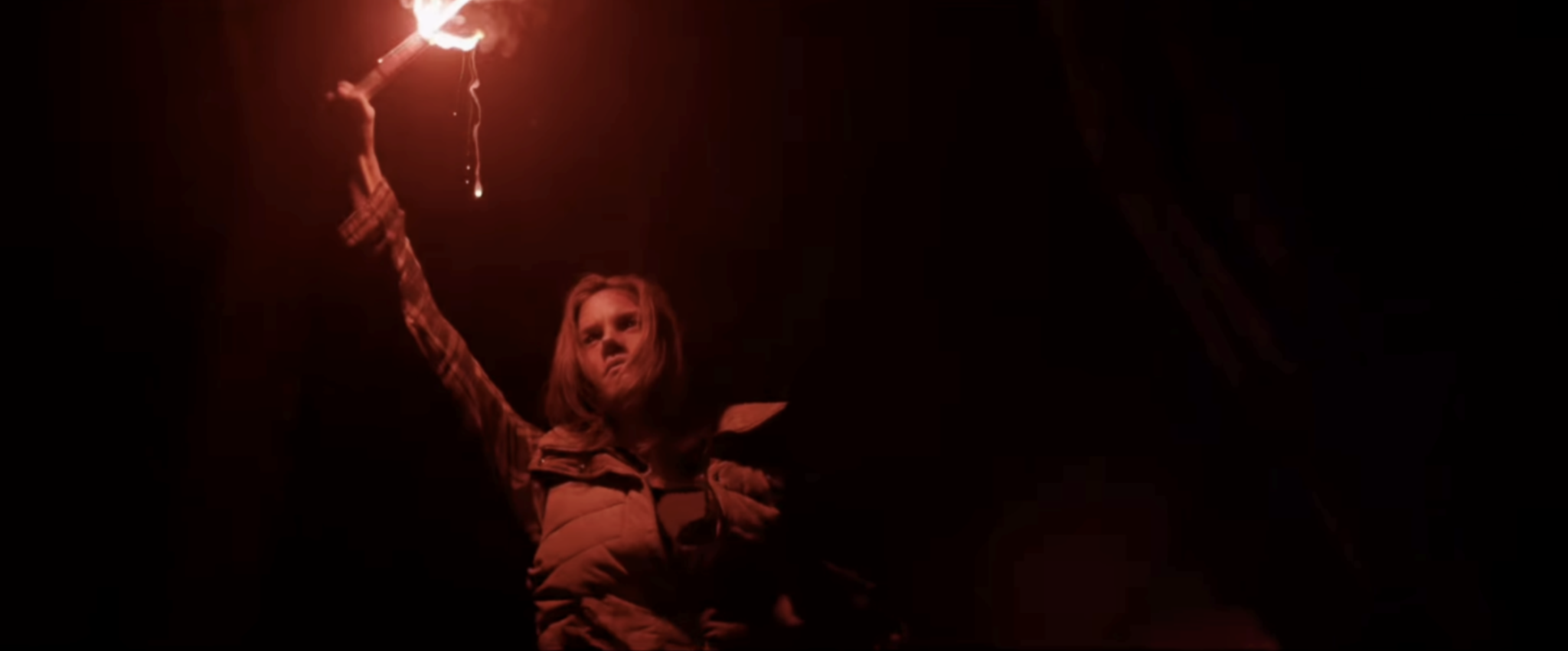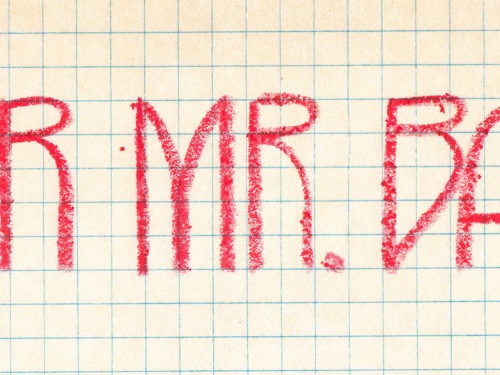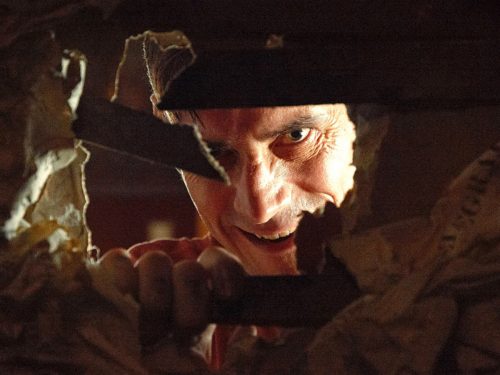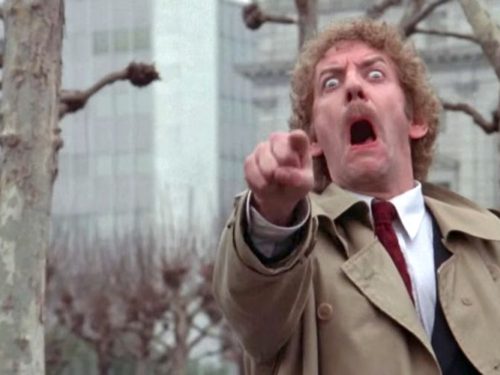A standout in a crowded field of movies about people getting lost and stalked in the woods, Backcountry captures the primal terror of nature’s indifference
“Jewel, you must never listen to this,” says a trembling, visibly shaken Werner Herzog. Shot from behind, over his shoulder, he has just listened to the audio recording of the death, by bear attack, deep in the Alaskan Grizzly Maze, of Timothy Treadwell, the subject of his classic documentary Grizzly Man (2005). He is shielding one of Timothy’s close friends from the unspeakable horror documented on tape. “You should destroy it,” he advises. This oft-quoted scene from the film is a potent, evocative moment that’s lodged in the collective memory. It’s one of those indelible Herzogian segments that echoes through the Internet, repeated and reenacted at random, and taken as a challenge by some. Even so, the scene retains its raw emotion through almost unbearable suggestion. In a sense, the audience is spared the experience of the attack. In another, it’s impossible not to imagine what that might have sounded like — the screams, the panic, the brutality of it.
It’s crass to compare a real-life tragedy with a piece of horror fiction — let’s acknowledge that. However, bear attacks deep in the wilderness are a staple of genre filmmaking. For my money, writer-director Adam MacDonald’s 2014 debut feature, Backcountry, captures a fragment of this primal terror, which Herzog succinctly, disquietingly referred to as “the overwhelming indifference of nature.” Backcountry features, as its centerpiece, as its undeniable pivot point, one of the most upsetting animal attacks in film. It’s abrupt, ugly, and inevitable, taking cues from classic horror staging then deploying a mixture of stomach-churning sound design, inventive gore effects, and decoupage. It’s not the cartoon type of violence so typical of movie bear attacks — in something like The Edge (1996), Into the Grizzly Maze (2015), or The Revenant (2015) — where characters clamber into a crevice out of the animal’s reach, or they fend off scratching paws until someone pops into frame to save the day, or where everyone looks away as their friend is mauled. Rather, the impact of claws and teeth against vulnerable flesh is felt.
The first blow, in the leg when Alex (Jeff Roop) is grabbed in the tent, exposes his tibia; blood pours out and he screams about not being able to feel his foot. The second pull makes the finality of the kill immediately apparent. As he writhes in agony, in jittery extreme close-ups, we see the flesh hanging off his ravaged face, his eyeball bulging out from the tears and bites, and we hear tinnitus ringing meld with the piercing screams. When Jen (Missy Peregrym) doubles back, in a state of shock and panic, to grab the engagement ring from their backpack, we see Alex’s carcass; he’s ripped in half, his ribcage exposed. The three distinct parts of the sequence — the first strike and the realization of what is happening, the kill and the shrieks of pain, and the aftermath once it’s done — are horrifying and visceral and over in a few minutes. In a recent episode of Fresh Air, science writer Mary Roach describes the forensics of animal crime scenes; detailing the scene typical of bear attacks, she says, “Bears tend to do what they do when they fight amongst themselves, which is they go for the face. The face is lightly furred, so… horribly, that is where they go first when they are attacking a person… It’s a messy scenario, a lot of bite, bite, bite.” Backcountry depicts this messiness.
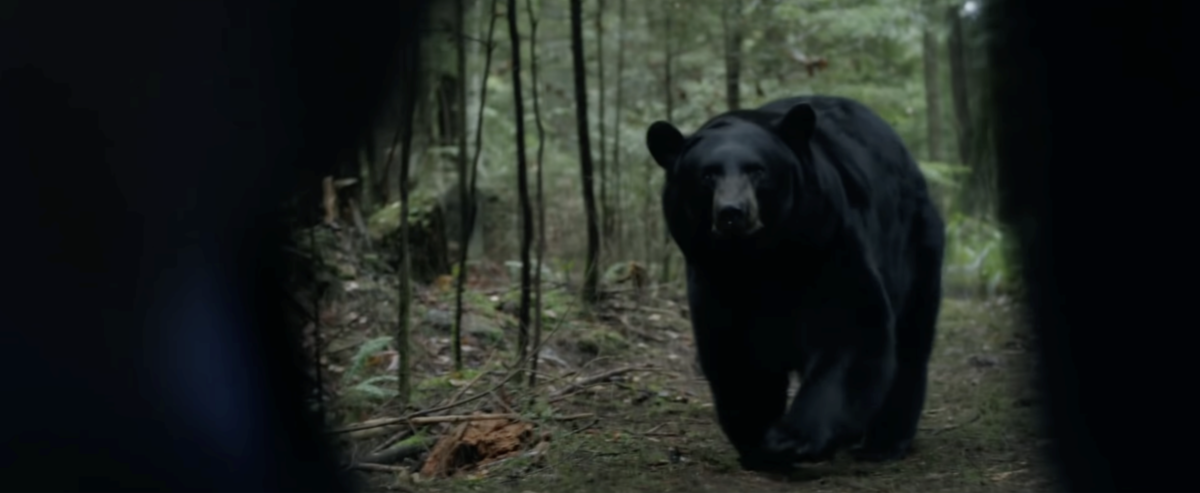
And it elevates Backcountry, making the film a standout in a crowded field of movies about people getting lost in the woods and stalked by something — be it man, beast, or some kind of unholy hybrid. What’s striking in revisiting Backcountry is how thoroughly it structures itself as a horror movie. Hinging on that scene, it almost functions like a slasher film, with a hungry bear transposed in for Jason Voorhees. Its setup, mood, setting, tension/release rhythm, dynamic between the central couple, glimmers of rednecksploitation, and, eventually, it’s turn toward a more surreal, stylized form of storytelling in its final act — with nods to the Final Girl trope — consistently, self-consciously tips the genre balance decisively toward horror. But that bear attack gives it such a different dimension that throws the horror movie expectations off-axis. This is a story that invests in the central relationship, much more so than its forebears in the survival-horror-slasher subgenre, and it rewards that attention with a moment of pitiless violence that deepens the tragedy of the preceding interactions and renders them moot. In keeping with Herzog’s quasi-Hobbesian perspective, unlike other movies on its branch of the horror genre tree, it doesn’t frame this killing as metaphor. The couple makes a fatal mistake, compounds that mistake, and the outcome follows.
In a sense, the plot of Backcountry is as old as storytelling itself — a don’t-go-in-the-woods parable given modern stakes. A couple — Alex and Jen — take a weekend trip to tune out and bond while hiking the Blackfoot Trail to a spot overlooking a lake, ostensibly a locale that holds cherished memories for Alex. After enduring a less-than-romantic first night camping, sullied by their encounter with a predatory local guide (Eric Balfour), they continue on and venture off the beaten path. When Alex is sure they are coming up on their spectacular lakeside overlook destination — and his planned proposal point — they see nothing but miles of forest before them and realize they have been lost for days. They attempt to double back, retracing their route, but end up deeper in an increasingly hostile wilderness.
The woods — with its odd angles, blotted out sunlight, and apex predators with home-field advantage — have always been, and will always be, a forbidding environment primed for horror. Centuries of fables warning children not to stray into the forest paid off in the early-’80s with a rash of slasher flicks that made hay with this same basic concept — augmented with nubile co-eds and machetes, naturally. In contrast to the imaginary, arbitrary dividing lines of the modern world, the off-limits sections of the forest are dictated by migratory patterns, hibernation cycles, hunting zones. They are predictable, identifiable, seasonal, and inflexible. The woods are marked as a zone adjacent to civilization, and there’s a double-edge to that: the setting is a magnet for young people looking for illicit good times, but, when things inevitably go awry, the lost thrill-seekers are helpless and outmatched by horrors that are far beyond their control. The majority of the movies of this ilk heighten the threat by adding an unnatural or supernatural element. Your Jasons are superhuman and unkillable, Berserker (1987) unleashes some vaguely Nordic mythological man-bear hybrid (a pathetic-looking foe when he’s finally seen), and Don’t Go in the Woods (1981) and Just Before Dawn (1981) lean into the Wildman mythos, where some sadistic backwoods yokel kills anyone who wanders into view just for yucks.
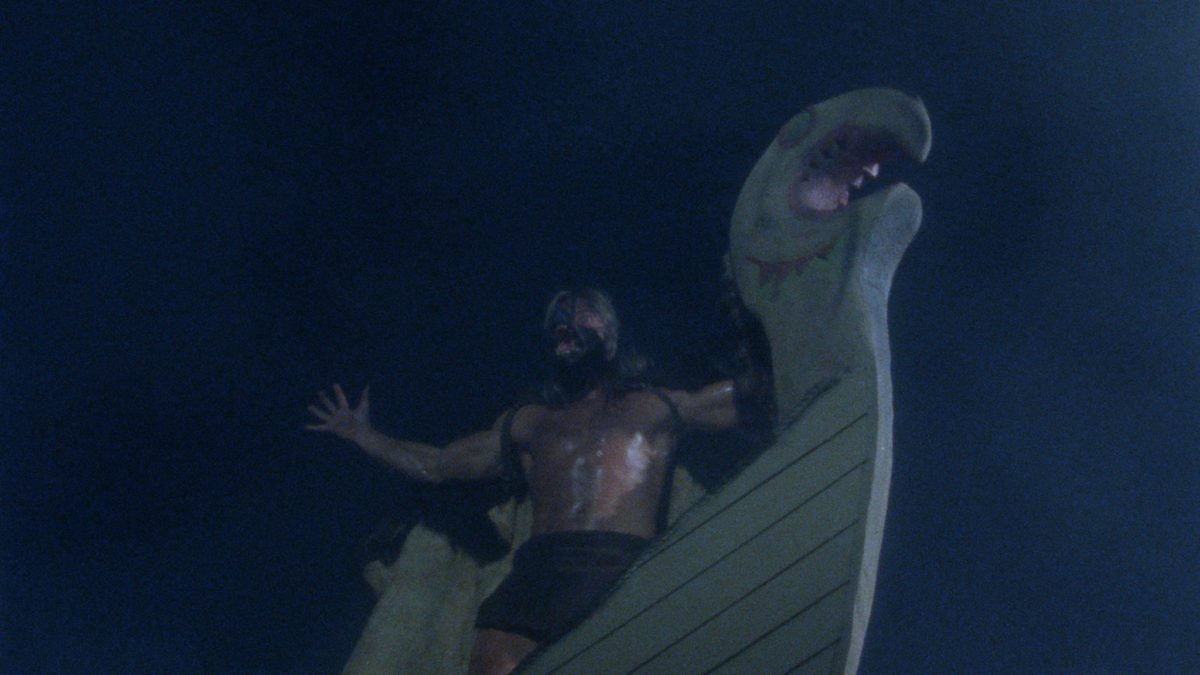
So why venture into the woods in the first place? The motivations are remarkably consistent across the subgenre. What drives these mostly young people to go into the wilderness is simple but also, paradoxically, kind of loaded. There’s the simple thrill-seeking — good times and T&A far from the strictures of society. But there’s often more to it than that: an attempt to reconnect with a cherished memory, typically from childhood, that gives at least one member of the party a deeper connection with the land, and a working memory of the terrain. Backcountry also makes a play at one of the core tenets of this camping-horror subgenre: inverted male-female power dynamics. The men in these stories — typically the ones with those cherished childhood memories — almost always enter the forest cocksure, with an unearned swagger, lacking a healthy fear of the potential dangers, and overestimating their competence. By the end, if they survive the ordeal, they are typically cowering, ineffectual, paralyzed, impotent. Conversely, the women in the party, often having reluctantly tagged along for what amounts to a macho primal ritual, have to pick up the slack. Just Before Dawn provides the ne plus ultra example when, in the final minutes of the film, Constance (Deborah Benson), out of pure instinct, rams her fist down her attacker’s throat, suffocating him to death, which leaves her boyfriend — Warren (Greg Henry), the only other survivor — trembling on the ground, stabbed in the gut, in awe of her fortitude and savageness. In Backcountry, Jen comes prepared; she has bear spray, flares, and extra provisions. Alex chides her for it. These supplies are foreshadowing, yes, but they are also indicative of her frame of mind when venturing into a quasi-primeval space. The polarity in their relationship shifts gradually, then abruptly. Eventually, alone in the middle of nowhere, she outmaneuvers the bear, fights through a compound fracture to keep moving forward, and claws her way to the parking lot.
A lot of these survival-horror movies follow a well-worn path. Take Grizzly (1976), a blatant Jaws knock-off where a local sheriff hunts down the “ginormous” (per the streaming description) title character that is running roughshod over the countryside and laying waste to unwitting campers. Eventually, inevitably, the film culminates in the climactic showdown where the sheriff explodes the bear with a grenade launcher, as one does. Don’t Go in the Woods follows suit. It’s not a bear-tagonist, but it is a rogue woodsman dressed up in a lot of beads and fur doing the indiscriminate killing in the strangely crowded forest. Again, a contingent of local law enforcement hunt down the threat. A couple of last-standing campers, who survived a previous encounter, take revenge just before the police arrive, saving them the trouble. Point is, the film ends with the final confrontation and the nullification of the Big Bad. So too with Berserker (1987) — both a bear and a man-bear! — where the titular mythological whatsit is gunned down by the local sheriff. If you want to get technical, both Berserker and Don’t Go in the Woods end with the twist that a new monster is created to take up the mantle of the one that just bit the dust.
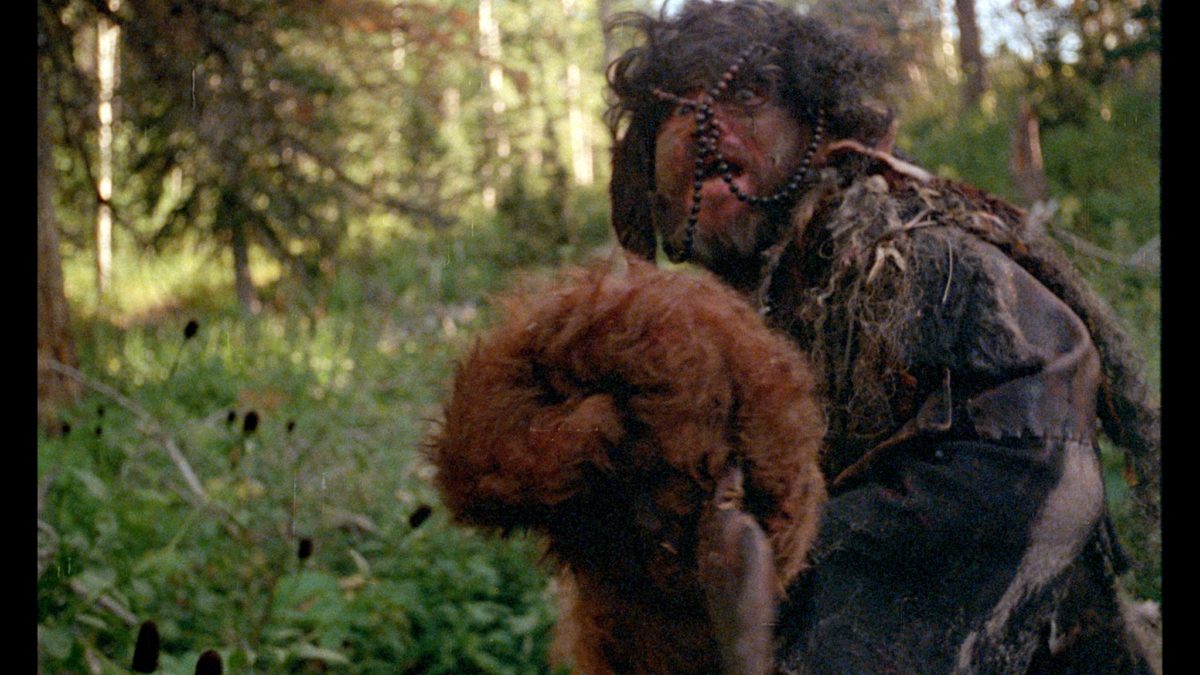
Backcountry is in conversation with this somewhat disreputable horror subgenre. We get the opening sense of doom (a slow pan down as the flies buzz around an unidentified carcass) followed by the hammer-on title card. The couple takes their long drive out — to the tune of the Dwight Twilley Band’s “Looking for the Magic,” no less, of You’re Next (2011) fame — emphasizing their contentedness and the distance they are traveling from help. They encounter the checkpoint, the Blackfoot Trail, but they ignore the signs that it’s closed. This is typical of these films: in Berserker, for instance, this happens twice. First, when the sheriff calls the kids out for tossing their Miller Lite on the side of the road, then again when Pappy informs them that their desired cabin is occupied; in Just Before Dawn, George Kennedy, horticulturist and US Forest Service rep, has the thankless task of telling the would-be campers that they are not likely to make it back down the mountain. The Backcountry pair also goes skinny dipping almost immediately, complete with a POV shot of someone leering. Both the dip in the watering hole and the first-person voyeurism are basically required for these types of movies. It even intimates that this is a movie about outsiders getting stalked by a townie. They encounter a local guide as night falls, who worms his way into a dinner invite before he gradually turns more menacing. This guy is, we find out, a red-herring — amusingly, he literally shows up with a bunch of fish in hand — but his presence lingers far into the forest on first watch. He also serves as seasoning, brandishes a knife briefly to give a little slasher flavor; and he micturates in front of them, foreshadowing the territoriality of the bear. Again, as is so often the case with these films, the threat of man and the danger posed by the wild beasts is blurred.
Backcountry, though following a similar setup, functions totally differently in the end. The threat is more primal, less sensationalized. It’s not the bear, it’s a bear. There’s no way to confirm that the bear that mauls Alex to death is the same bear that pokes its nose in their tent earlier in the movie. The film is a streamlined machine, and it switches gears between different modes of horror storytelling. First, it leads to an interaction with a local with nefarious intent, then it moves into a lost-in-the-woods-with-few-supplies scenario, then comes the piece de resistance with the gnarly bear attack — which cleaves the movie and stops it in its tracks — before slipping into a more surreal, concussed mode for its final stretch, as the spent heroine, half-conscious, stumbles her way out of the forest. The movie takes an odd approach in that there is little structure to their encounter with the beast. There’s an arc to it, yes: They stumble across a deer carcass, they realize they have strayed, they inspect some tell-tale signs of activity around their camp, they have a sleepless night deep in the woods with cracks and noises nearby, then everything comes to a head the next morning. But it is also random and abrupt. They are not eluding the bear so much as trying to find their way back to recognizable landmarks — they are lost basically the whole time; Alex did not have as clear a memory of the area as he thought, an echo of a similar situation in Berserker. It’s less a hunt than a situation where they are circling their tracks deep in bear country just before hibernation season. And the rhythm of how these attacks often go down in camping-horror is subverted. The confrontation happens first thing in the morning. A false sense of security has set in with the reassurance of the fresh sunlight; they have a quick laugh and feel relief that they made it through the night. But they open the tent flap and a large black bear is within sight, seated at the edge of their camp. In a masterful touch, Alex opens and closes the flap several times, obscuring our view of the bear briefly before revealing that its interest has been piqued and it is moving toward the tent. The perceived safety of the tent flap, and the sheer tent canopy, is a recurring gag throughout this subgenre — especially in found-footage iterations like The Blair Witch Project (1999) or Willow Creek (2013) — and Backcountry makes excellent use of it.
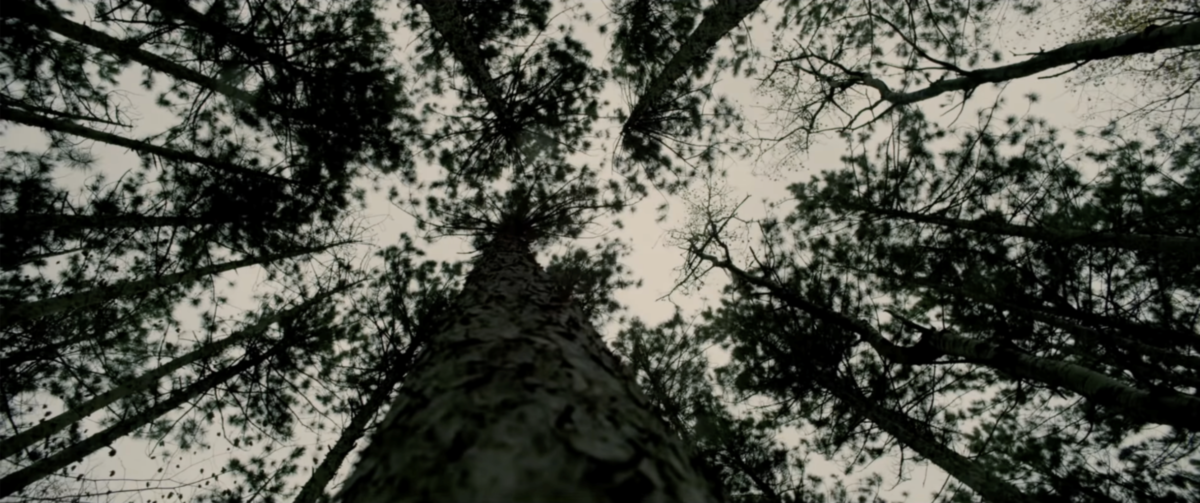
One of the great things about MacDonald and cinematographer Christian Bielz’s compositions is that they set a gloomy tone and undercut any sense of optimism. Alex and Jen are sunny and excited on the ride in, but the clouds roll in and remain overcast, occasionally outright threatening. In fact, as the movie progresses, and the pair gets deeper in the woods, everything looks more lifeless. They entered the forest at the end of autumn and the season seems to rapidly shift toward a hostile early winter. The style of the movie shifts periodically, too. Starting out smooth and relatively calm — with disruptions, such as that leering POV shot, scattered purposefully — as the situation intensifies, edgy, intimate handheld shots become the norm. After the bear attack, everything is a bit more psychedelic and stylized: the red glow of the flare lighting Jen’s way through the night, her pace slowing to almost nothing, the swaying and creaking of the trees more pronounced, insert shots of her standing motionless in the underbrush (a la Blair Witch or even, dare I say, Unedited Footage of a Bear), her vision of an elk, and her sleeping while dangling from a tree limb.
Billed as a horror film, structured in the classic camping-out horror subgenre mode, Backcountry functions as something of a corrective in the continuum of into-the-woods horror slasher films. Zooming in further, it recalibrates the sub-subgenre of horror films where people mill about the woods and face off against an ursine — man-bear hybrid, mutant bear, Wildman, what have you — threat. These films follow a similar path, and the villain varies in terms of ridiculousness, but, in the end, campers get picked off by a territorial antagonist with ties to the woodland environment. Part monster movie, part survival horror, part wilderness adventure: call them Darwinian Slashers.
Find the complete October Horror 2021 series here:
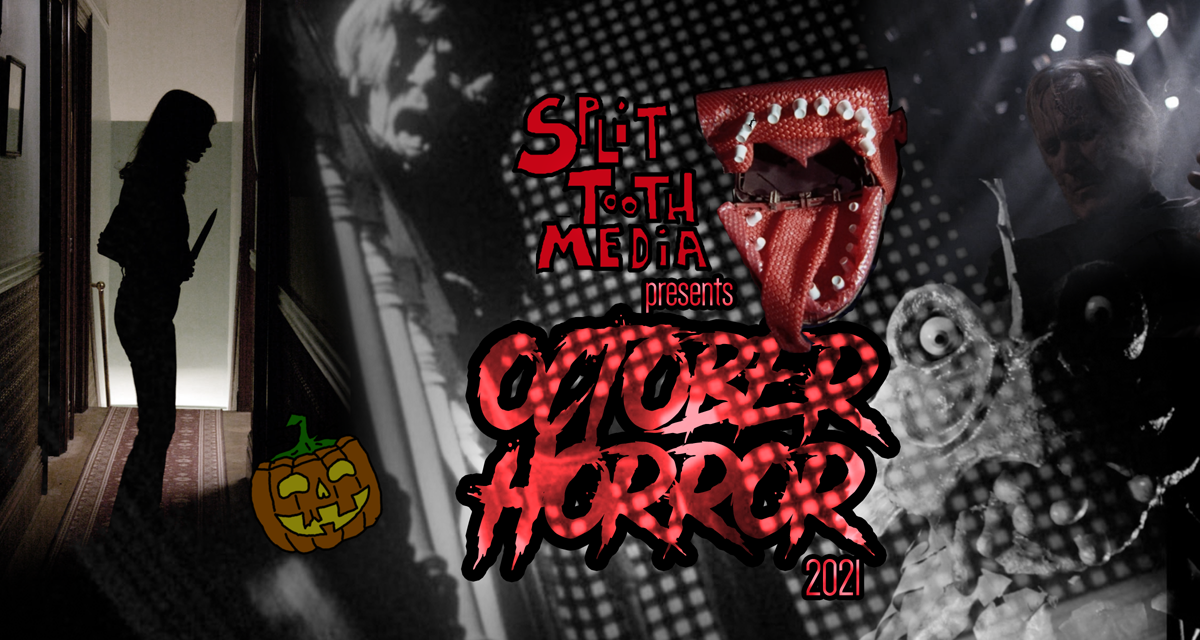
Stream Backcountry on Amazon
Follow Split Tooth Media to stay up to date with all things October Horror
(Split Tooth may earn a commission from purchases made through affiliate links on our site.)

